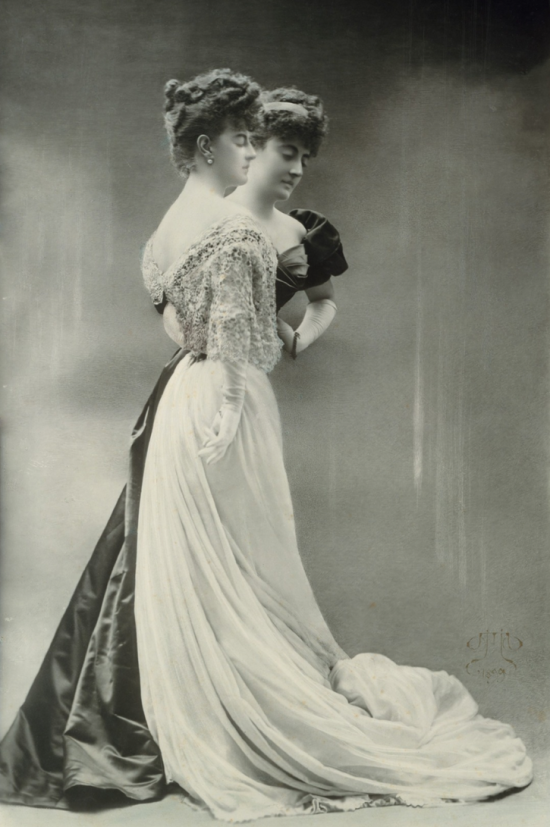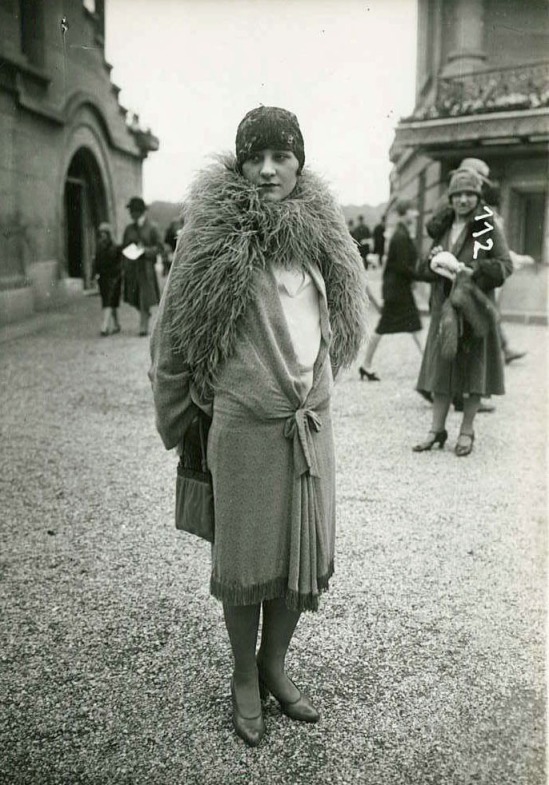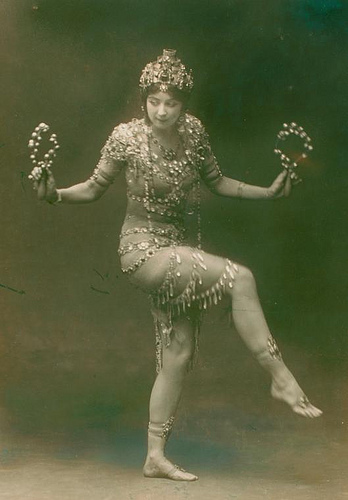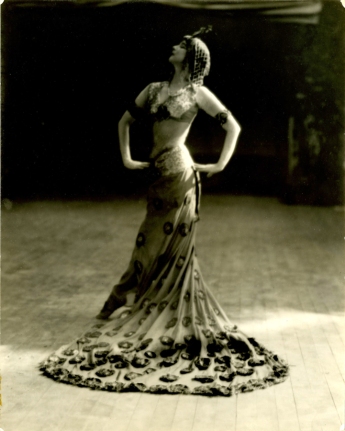Colette, 1900s via
Tag Archives: France
Vintage Photos of French Salon Queen Comtesse Greffulhe (1860-1952)
Aristocrat, Élisabeth, Comtesse Greffulhe (1860 – 1952) was a renowned beauty and queen of the salons of the Faubourg Saint-Germain in Paris. She was the daughter of Joseph de Riquet de Caraman and his wife Marie de Montesquiou-Fezensac. In 1881 she married the unfaithful, quick-tempered Henri, Count Greffulhe (1848-1932), of the Belgian family of bankers. The comtesse has been described in these words:
“The Comtesse Greffulhe is always beautiful and always elsewhere. But it would be a mistake to think that her life was merely the pursuit of pleasure (…) not only is she beautiful, but she is a lady. Preferring the privacy of her own house in the rue d’Astorg and at Bois-Boudran in the country, the Comtesse Greffulhe never dined out except at the British Embassy. When Edward VII came to Paris, he dined informally at her house. After a restricted youth (…) she set herself to attracting musicians, scholars, physicists, chemists, doctors.”
She regularly entertained the cream of Parisian society at her salon in the rue d’Astorg. The comtesse helped establish the art of James Whistler, and she actively promoted such artists as Auguste Rodin, Antonio de La Gandara and Gustave Moreau.
She was the inspiration for the Duchess of Guermantes in Marcel Proust’s In Search of Lost Time, she regularly ordered – notably from Worth – sumptuous outfits that highlighted her splendid waist. She was a patron of Sergei Diaghilev’s Ballets russes, and launched a fashion for greyhound racing.
Fascinated by science, she helped Marie Curie to finance the creation of the Institute of Radium, and Edouard Branly to pursue his researches on radiotransmission and telemechanical systems.

Comtesse Greffulhe photographed by Otto Wegener (around 1886)

Comtesse Greffulhe wearing a ball gown photographed by Otto Wegener (ca. 1887) via

Comtesse Greffulhe looking sideways photographed by Félix Nadar, 1900 via

Comtesse Greffulhe shows off her bare shoulder and, fashionably semi-concealed, her striking figure in a turn-of-the-century dress via

In this puzzling image, Comtesse Greffulhe is seen embracing her own double. The Comtesse wears an elaborate dress with decorated blouson bodice and swirling fabric and a simple dress that could be worn today, 1899 via
Stunning Images of 1950s Paris by Sabine Weiss
Sabine Weiss was born in Switzerland in 1924. In 1942, she wonders what she will do with her life, and decides that she should become a photographer because it is what she loves to do.
In 1945 Sabine Weiss moved to a studio in Geneva, but in 1946 she decided to leave the city of her childhood to live in Paris. She knew there was no turning back. She asked Willy Maywald to become her assistant.
In 1949, she met the painter Hugh Weiss and realized right away that she would spend her life with him. Sabine Weiss left Maywald, where she mastered her craft and started a long career, experimenting fashion, photojournalism, advertising and everything else she was asked to do (source).

Sabine Weiss, Paris, 1955 via

Sabine Weiss, In the rain, Paris, 1957 via

Sabine Weiss, July, Paris, 1954 via

Sabine Weiss, St. Lazare train station, Paris, 1949 via

Sabine Weiss, The Eiffel Towers dry, Paris, 1956 via

Sabine Weiss, Bilboquet, La Concorde, Paris, 1950 via

Sabine Weiss, Snow, Paris, 1952 via

Sabine Weiss, Paris, 1953 via
France, Turn of the Century, by The Seeberger Brothers
Fashion at Longchamp 1912 by Seeberger Frères
Three Photos by Robert Demachy (1859–1936)
Robert Demachy (1859–1936) was the leading French Pictorial photographer of the late 19th and early 20th century. Pictorialism began in response to claims that a photograph was nothing more than a simple record of reality, and transformed into an international movement to advance the status of all photography as a true art form.
Demachy is best known for his intensely manipulated prints that display a distinct painterly quality. Demachy was particularly interested in nonstandard photographic processes and is noted especially for his revival of the gum bichromate process (invented in 1855 but little used until the 1890s), which allowed the introduction of color and brushwork into the photographic image (source).
He gave up taking photographs in early 1914, and never again touched a camera, even refusing to take snapshots of his grandchildren. No one was ever able to extract any reason from him for this sudden change, and it remains a mystery to this day.

Dans les coulisses by Robert Demachy, ca. 1897 via

Behind the Scenes of the Opera by Robert Demachy via

Behind the Scenes by Robert Demachy, 1906 via
A Collection of Vintage Photos Feat. 1920s Street Style
Beautiful Vintage Photos of Ruth St. Denis
Ruth Saint Denis (January 1879 – 1968) was a modern dance pioneer, introducing eastern ideas into the art.
While touring in Belasco’s production of Madame Du Barry in 1904 her life was changed. She was at a drugstore with another member of Belasco’s company in Buffalo, New York, when she saw a poster advertising Egyptian Deities cigarettes. The poster portrayed the Egyptian goddess Isis enthroned in a temple; this image captivated St. Denis on the spot and inspired her to create dances that expressed the mysticism that the goddess’s image conveyed. From then on, St. Denis was immersed in Oriental philosophies.
Like Loie Fuller and Isadora Duncan before her, St. Denis felt that Europe might have more to offer her. She left with her mother for London in 1906, and traveled the continent performing her “translations” until 1909, when she returned to give a series of well-received concerts in New York City and on tour in the United States. During the next five years she continued to tour, building her reputation as an exotic dancer with an artistic bent, a “classic dancer” in the same catagory as Isadora Duncan. These two artists were, however, inherently different in their approach to the solo dance. According to St. Denis’ biographer Suzanne Shelton, Duncan sought “the Self in the Universe,” and St. Denis sought “the Universe in the Self.” For St. Denis, the exotic worlds she intended to interpret could be seen from the vantage point of her body. One of her quotes reads as follows:
I see dance being used as communication between body and soul, to express what is too deep to find for words.
After 1911, the vogue for solo dancers on the professional stage died down. To support herself, St. Denis often gave private lessons to society women, including Gertrude Vanderbilt Whitney. In 1938 St. Denis founded Adelphi University’s dance program, one of the first dance departments in an American university. It has since become a cornerstone of Adelphi’s Department of Performing Arts.
Ruth St. Denis
Ruth St. Denis
Ruth St. Denis
Ruth St. Denis
Ruth St. Denis
Ruth St. Denis
Ruth St Denis in the ‘East Indian Nautch Dance’ (1932)
Ruth St Denis is seen here performing the Indian Noche (1932) one of her most famous pieces.























